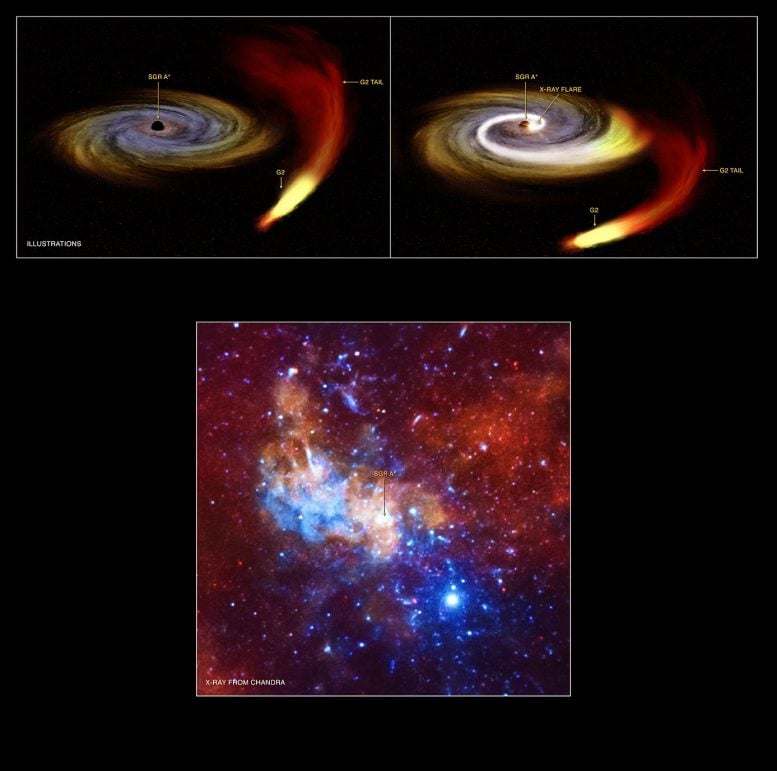
The Milky Way’s supermassive black hole has revealed some unusual activity, showing an increase in X-ray flares that coincided with the close passage of the mysterious G2 object near the black hole.
The Milky Way’s supermassive black hole has revealed some unusual activity, showing an increase in X-ray flares that coincided with the close passage of the mysterious G2 object near the black hole. A team of astronomers will continue to observe the black hole to ascertain the true nature of the increased X-ray activity.
Three orbiting X-ray telescopes have been monitoring the supermassive black hole at the center of the Milky Way galaxy for the last decade and a half to observe its behavior. This long monitoring campaign has revealed some new changes in the patterns of this 4-million-solar-mass black hole known as Sagittarius A* (Sgr A*).
The bottom panel of this graphic is a view of the region around Sgr A* where red, green, and blue represent low, medium, and high-energy X-rays detected by NASA’s Chandra X-ray Observatory. Sgr A* itself is not visible in this image, but is embedded in the white dot at the end of the arrow. The other two telescopes involved in the 15 years of X-ray observations were ESA’s XMM-Newton and NASA’s Swift Gamma Ray Burst Explorer, but their data are not included in this image.
Within the past year, the usually quiet black hole has shown an increased level of X-ray flares over its typical rate. This surge in X-ray flares coincides with the passage close to Sgr A* of a mysterious object called G2. Astronomers have been tracking G2 for years, originally thinking it was an extended cloud of gas and dust. However, after passing close to Sgr A* in late 2013 its appearance did not change much, apart from being slightly stretched by the gravity of the black hole. This led to new theories that G2 was not a gas cloud, but instead a star or pair of stars within an extended dusty cocoon.
If the G2 explanation does explain the recent rise in X-ray flares, it would be the first sign of excess material falling onto the black hole because of the cloud’s close passage. Some gas would likely have been stripped off the cloud, and captured by the gravity of Sgr A*. It then could have started interacting with hot material flowing toward the black hole, resulting in an enhanced feeding rate and the production of X-ray flares. This scenario is depicted in the artist’s illustrations found in the upper two panels of the graphic.
While the timing of G2’s passage with the surge in X-rays from Sgr A* is intriguing, it is not yet an open-and-shut case. That is because astronomers see other black holes that appear to have behavior similar to the most recent increase of activity from Sgr A*. Therefore, it’s possible this increased chatter from Sgr A* may be a common trait among supermassive black holes and unrelated to G2. Instead, it could represent, for example, a change in the strength of winds from nearby massive stars that are feeding the black hole.
The analysis included 150 Chandra and XMM-Newton observations pointed at the center of the Milky Way over the last 15 years, extending from September 1999 to November 2014. An increase in the rate and brightness of bright flares from Sgr A* occurred after mid-2014, several months after the closest approach of G2 to the huge black hole. The newest set of Chandra, XMM, and Swift observations, obtained between August 30 and October 2014, revealed six bright flares within about three days, while an average of only 0.8 bright flares was expected.
A paper on these findings has been accepted by the Monthly Notices of the Royal Astronomical Society. The authors of this study were Gabriele Ponti (Max Planck Institute for Extraterrestrial Physics), Barbara De Marco (Max Planck), Mark Morris (University of California, Los Angeles), Andrea Merloni (Max Planck), Teo Muñoz-Darias (University of La Laguna, Spain), Maica Clavel (CEA Saclay, France), Darryl Haggard (Amherst College), Shuo Zhang (Columbia University), Kirpal Nandra (Max Planck), Stefan Gillassen (Max Planck), Kenji Mori (Columbia), Joseph Nielsen (Massachusetts Institute of Technology), Nanda Rea (University of Amsterdam), Natalie Degenaar (University of Cambridge), Regis Terrier (University of Paris), and Andrea Goldwurm (CEA Saclay).
Reference: “Fifteen years of XMM-Newton and Chandra monitoring of Sgr A*: Evidence for a recent increase in the bright flaring rate” by G. Ponti, B. De Marco, M. R. Morris, A. Merloni, T. Munoz-Darias, M. Clavel, D. Haggard, S. Zhang, K. Nandra, S. Gillessen, K. Mori, J. Neilsen, N. Rea, N. Degenaar, R. Terrier and A. Goldwurm, 6 October 2015, MNRAS.
DOI: 10.1093/mnras/stv1537
arXiv: 1507.02690








Be the first to comment on "Sagittarius A* Shows Signs of Increased X-Ray Activity"